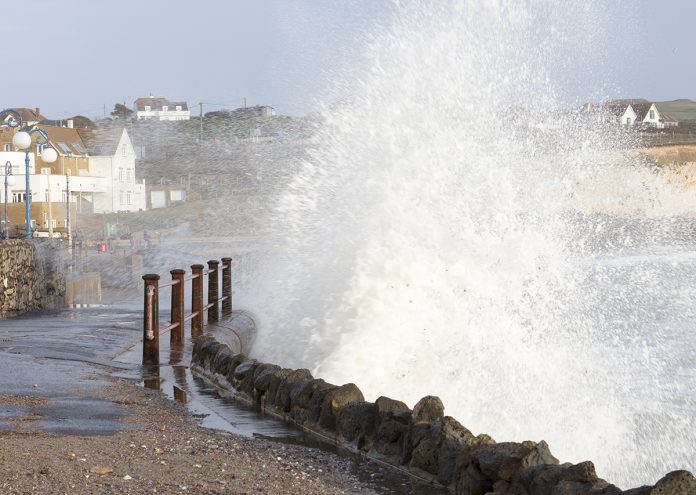The possibility of extreme coastal flood events could increase from the current rate of once every 100 years to every year by 2050, according to the Intergovernmental Panel on Climate Change (IPCC)
Coastal flooding has been identified as one of the top priority risks for the UK by the Cabinet Office. Extreme weather events can have huge impacts on society, the environment and the economy, and climate change can exacerbate the aftermath of such events.
Climate change, what is happening?
Climate change refers to long-term changes in average weather conditions, such as temperature and rainfall.
Recent UK Climate Projections (UKCP) suggest the daily maximum temperature for the UK will rise above 40C in 2100 if there is no effort to regulate greenhouse emissions.
The rising global temperature warms the atmosphere and ocean, causing land ice to melt and thermal expansion of seawater, which both contribute to sea levels rising. The magnitude of storm surges and wave heights will also increase as a result.
In short, a warmer world leads to higher sea levels. The UK has seen a 16cm rise in sea level since 1900 and it could increase to more than a metre by the end of the century, according to the Meteorology (Met) Office.
Coastal flooding in the UK
Coastal flooding occurs when coastal defences are overtopped or breached by seawater. Factors that drive coastal flooding include waves, tides, storm surges and relative mean sea level.
In 2014, high seas with strong winds destroyed a sea wall in Dawlish, where Devon railway was left vulnerable to waves and caused a projected loss of £35m.
Coastal flood risk will always exist but it is possible to minimise its impact on society, environment and economy.
Consequences of flooding have reduced over time due to improvements in flood defences and risk management. For example, in 2020, a new sea wall has been constructed in Dawlish to protect the railway and the town from future high seas and storms.
How is climate change related to coastal flooding?
According to Marine Climate Change Impacts Partnership (MCCIP): “Extreme sea levels exceeding critical flood-threshold are experienced more frequently than in the past due to mean sea level rise.”
Other factors can also increase coastal flood risks like coastal erosion and precipitation. However, an increasing mean sea level will be the foremost driver for extreme sea levels and flooding, and this increase is a result of climate change.
Rising sea levels will increase the chance of overtopping existing defences, making existing coastal flood defences more vulnerable and more likely to fail once overwhelmed.
Therefore, coastal defences need to be futureproofed by considering the results of climate change and having procedures to adapt to the everchanging climate.
Current and future outlook
There is an effort from the UK government, local authorities and bodies to reduce the climate change rate and impact.
In September 2020, the government adopted the National Flood & Coastal Erosion Risk Management Strategy for England to protect people and properties from flood events.
Cooperatives are also legally required to work towards the net zero carbon mission to reduce carbon emission by 2050.
Climate change is bound to happen but it can be controlled to achieve a desired outcome, reducing the impact it creates.
The ultimate goal is to limit human contribution to climate change and adapt to it.
In terms of the future of flood defences, it is essential to review the effectiveness of procedures in place and plan maintenance to prevent rising seawater overtopping or breaching existing defences.
Approximately 520,000 properties in the UK are in areas with high risk from coastal flooding, according to the Committee on Climate Change.
StormMeister® has successfully protected properties and lives from coastal flood events. We provide a range of easy-to-operate flood resilience products, including flood doors, windows, barriers and gates.
In Dawlish, we have protected a commercial property situated opposite to the Dawlish sea wall from floods with our StormMeister® wheelchair friendly low threshold flood door.
Our certified flood doors can protect properties from floodwater level of over 600mm.
If you are looking to safeguard your family and property from floods, we are here to help. Feel free to speak to us on 01772 704429 or send an email to contact@stormmeister.com
Claudia Mak
Head of Design
William M Snape Manufacturing (UK) Limited T/A StormMeister Flood Protection
Tel: +44 (0)1772704429
Twitter: @stormmeisterfp
Facebook: StormMeister
YouTube: William Snape
Interesting reads:
MCCIP. Report Card 2020.
Environment Agency. National Flood and Coastal Erosion Risk Management Strategy for England.
IPCC. Global Warming of 1.5 ˚C.
Met Office. UK Climate Projections (UKCP).
Network Rail. Five years since we reopened Dawlish.
Please note: this is a commercial profile.

















